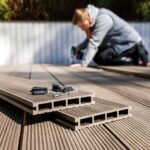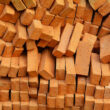Yes, a fire pit can damage your concrete patio over time resulting in cracks or discoloration of surface. The oils and chemicals form the fire pit can seep inside the porous concrete resulting in permanent damage. For concrete, some extreme temperatures like that of fire pit can be detrimental.
But this doesn’t mean you can say big “no” to the fire pit on patio. There’re still some factors to consider and several ways to have a fire pit. You can have a fire pit that won’t even touch the concrete patio and avoid all those harmful consequences.
So, in our today’s post, we’ll see if fire pits on concrete patio is safe or not? And If not? What do you put in the bottom of a fire pit on concrete to help save your patio against long term effects?

Fire pit on patio – how it is to have?
There’s something really calming about sitting around a fire pit outdoors. It’s like having a cozy campfire in your own backyard.
But you know what? Sometimes, we forget that the fire pit can get super hot. Luckily, there are things we can do to stop the heat from ruining our cement patio. If you’re curious about how to do that, just keep reading!
Also Read: Concrete Pad for Hot Tub – Thickness – How to build one?
Is it safe to have a fire pit on concrete patio?
No, leaving your fire pit unattended can cause severe damage to your concrete foundations and even compromise the structural integrity of your home.
Anyhow, it is understandable that people are concerned about their concrete patio being damaged by a firepit because temperatures can reach extremely high levels. In most wood-burning fire pits, the bottom is made of wrought iron, aluminum, or copper, which conducts heat well.
People will love this when they’re crowded around it for warmth. When you have it just six inches above your cement patio, it’s not so good.
Like Us on Facebook!
An unprotected concrete patio will be damaged over time by a wood-burning fire pit. Most of the time, it doesn’t result in an explosion, but rather appears as rapid erosion or discoloration. Unlike wood fire pits, propane ones don’t have the same problems. With the help of a quality fire pit mat, you can easily resolve this problem.
Subscribe Us on YouTube!
While some fire pits can seriously damage concrete patios, others are remarkably safe. If your unit is one of the most dangerous ones, though, you can still mitigate its effects.
Also Read: How Much Slope is Required for Patio Drainage?

Will fire damage concrete?
No, concrete in general is resistive to heat and in non-flammable to some extent. In fact, in comparison to steel; it provides fire protection quality that’s critical for buildings. But still, long-term exposure of fire is detrimental to concrete. It losses the strength when exposed to burning for long period of time.
What do you put in the bottom of a fire pit on concrete?
If you’re still interested to place fire pit on concrete patio, it is best to use silica sand. It acts as a protective barrier that can be your additional layer of heat protection. Silica sand is affordable and is easily available to such applications. Just make sure to have an enclosure for the sand so it won’t slip off from the bottom upon loading with the fire pit.
Also Read: Benefits Associated With Ethanol Fireplaces
How Can Fire Pits Damage Cement concrete patio?
Let’s see some secrets of the clash between fire and concrete.
Did you know that fire pits can harm cement in unexpected ways?
Let’s take a journey to explore the interesting story of how fire and concrete interact.
Fire dries out the moisture from inside the concrete creating pockets of air that will result cracks in concrete.
Imagine the strong heat of fire touching concrete. Fire can make concrete lose its water, making it gradually dry out.
Concrete changes as it gets older, and it always has some water inside. But when fire comes, it takes away the water, which leads to small air pockets and cracks in the concrete.
Aggregates of limestone – But there’s more to the story when different kinds of concrete are involved. For example, there’s quick-mix concrete with limestone as a main part. This limestone is strong, but it can’t handle high heat. It breaks down, making cracks and causing the concrete to weaken.
Aggregates having quartz – On the other hand, there are quartz aggregates, used in different concrete types. Unlike limestone, quartz doesn’t fall apart under heat. It expands bravely, standing strong even when tested by fire. A patio made with quartz-infused concrete has a different story to tell – one of toughness.

Also Read: How to calculate cement sand and aggregate quantity in M15 concrete?
As a side note, remember that if you love outdoor fire pits, having a reliable fire extinguisher is like having a hero by your side. It’s ready to help, silently waiting. Make sure to keep it in good condition and up to date so that it’s ready to protect when needed.
The lesson is clear: fire pits and cement have a complicated relationship, each leaving a mark in the ever-changing story of materials and flames.
Ways to safeguard your patio from fire pit hazard and effects
Securing your outdoor space from the fiery effects of a fire pit demands smart planning. Get ready to uncover a treasure trove of tips that will turn your outdoor haven into a stronghold of safety.
Heat-Resistant Mats and Pads
Imagine having a shield that keeps the intense heat away, protecting your wooden or concrete deck. Meet the heroes – heat-resistant mats and pads – that lie beneath the raised fire pit.
These defenders are designed to stand strong against the powerful heat and flames. They’re easy to set up and portable, so you can take them along on outdoor adventures.
Also Read: Heat Resistance Concrete: Unlocking Durability in High-Temperature Environments
Fire Pits with Protective Screens
Think of sparks jumping out of the fire pit, potentially igniting things like fabric or dry leaves. The solution? Enter the trusty spark screens, the guards of your fire pit world. They stand firm, making sure sparks, embers, and ash stay inside the pit and don’t cause harm.
You’ll find various shapes and designs, from the classic semi-circular dome with a handle and mesh shield, to hinged spark screens with doors that open up like a secret treasure box.
Also Read: Unlock the Door to Rental Success: Exploring the DSCR Program Details
Staying Watchful and Careful
Embrace the wisdom of being a vigilant caretaker. Clearing away flammable items from around your fire pit and sweeping up dry leaves are smart steps to reduce risks. Promise to never leave your fire pit unattended, especially at night. Keeping an eye out and being ready to put out any flames will keep your space peaceful and safe.
In the dance of fire and safety, these strategies work together like a harmonious melody. Your once-vulnerable patio now stands strong against the unpredictable nature of fire, thanks to these clever protectors of outdoor serenity.
Using fire pad protector
For better heat insulation, consider using a real fire pad protector that sends heat back upwards to the fire pit. These protectors help minimize the spread of heat and are usually crafted from a material that bounces off the warmth.
These kinds of products will need a bit of space between them and the fire, although not as much as what an ember mat needs.
Using fire bricks or concrete pavers
Last but not least, one of the best ways to shield your concrete is by placing fire bricks or concrete pavers over your concrete patio, creating a barrier between your fire pit and the concrete underneath.
Even though this might not look the best, you can arrange the pavers in a neat way that doesn’t stand out, and you can even position your fire pit right on these bricks for added safety.
Will a Fire Pit Damage Pavers?
Yes, as pavers are constructed from concrete, it’s important to recognize that fire can cause harm to them. However, the advantageous aspect of pavers lies in their disposability. In the event of cracks, you can swap them out at a reasonably low expense while keeping the foundation of the patio intact.
However, there’s a catch when it comes to utilizing clay pavers, also known as fire bricks. Have you ever wondered why brick ovens are made from them?
Well, these bricks can endure temperatures exceeding 2000 degrees Fahrenheit and more. Opting for brick pavers might be your optimal choice to safeguard your concrete surface, as they are less prone to fracturing.
Can You Build a Fire Pit on Your Concrete Patio?
Building a fire pit on your concrete patio can be done with the right materials. Opting for a concrete fire pit is okay, but make sure you line the inside with fire bricks.
To build the concrete pit, you’ll also need heat-resistant ready-mix mortar.
By using this specific mortar, you can complete your concrete fire pit. .
This secures the fire bricks onto the concrete’s surface, forming a protective barrier between the fire and the actual concrete. Keep in mind that these products dry rapidly, so plan out your pit construction carefully before you start mixing.
When dealing with heat and concrete, it’s essential to choose concrete that contains limestone-based aggregate. This type of concrete is more heat-resistant compared to quartz/silicate-based aggregate.
For crafting heat-resistant concrete, opt for refractory cement with limestone-based aggregate. There are various versions of this cement available; follow the instructions on the container for proper application.
Remember, pouring concrete directly over fire bricks defeats their purpose, as the concrete layer on top will eventually crack and expose the bricks. Instead, use the fire bricks as a lining within your fire pit, held together with high heat mortar.
The bottom line
In conclusion, fire pits can pose risks to concrete patios through heat and chemicals, but strategies like heat-resistant mats, protective screens, and proper materials offer ways to enjoy them safely.
Concrete’s durability against fire varies, yet precautions can maintain a balance between the allure of fire pits and the protection of your patio’s integrity.


















